A River Worth Fighting For
by Dennis Montgomery
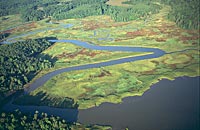
An aerial view of a creek that flows into the York River, as it winds through time and green expanse.
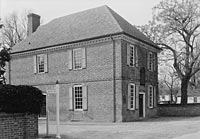
Library of Congress
Yorktown's Customs House, on the corner of Main and Read Streets, in Yorktown, Virginia. This black and white image is circa 1933.

Re-enactment of the October 1781 Yorktown battle where General Cornwallis met his match in American and French troops.
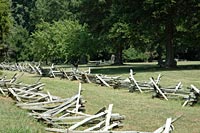
Dennis Montgomery
Surrender Field as it stands today in Yorktown, a grassy testament to General Cornwallis's surrender to General Washington on October 24, 1781.
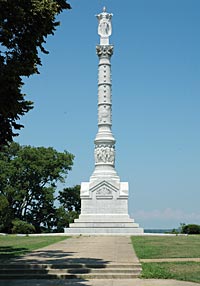
Dennis Montgomery
Begun in 1881 and completed in 1884, the Yorktown Victory Monument is a symbol of a victory that lead to America’s independence.
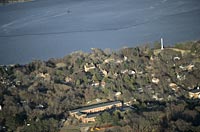
Dave Doody
The Victory Monument, Yorktown—Cornwallis' headquarters, the large brick Nelson House at center—and the York River today.
Roiled by the spume of conflict, threatened by the stain of pollutants, the storied York yet flows free, guarding its great bounty
In the grand panorama of the historic York River, the diminutive marsh periwinkle is as nothing...and as everything. Time out of mind, the puny, ubiquitous snail has glided among the cordgrass and arrow alum of the river's tidal wetlands and never erected to its passing a monument more substantial than the fragile form of its white spiral shell. Yet in the sweep of the river's saga the periwinkle's place is as enduring as the granite Yorktown Victory column, its slippery, shiny trail as integral a part of York's storied landscape as the networks of battlefield trenches.
For more than 400 years history-book heroes have come to the York to perform their parts in the dramas of human dominion and political supremacy. The periwinkle has haunted this stage the better part of 40 centuries.
If most men took their bows and went marching into the wings, some paused long enough to notice that the York River valley is an amphitheater for the productions of life itself, a coliseum for performances in which the stars have been fiddler crabs and catfish, great blue herons and snapping turtles, and, yes, marsh periwinkles. Every croaker, mullet, and spade fish; every cattail, hibiscus, and marsh-mallow acts its pivotal part in the exquisitely scripted interplay of species that ecologists bill as the balance of a river's natural environment.
A walk-on, man arrived about 4,000 years into the opening act, and, as they say, stole the show. Red, white, and black, man became with his impudence and his exploits the stuff of the York's facts and fables; his story became the river's history. Nevertheless, man's doings are but subplots, superfluities in a broader, essential epic.
Told out of the context of the York, isolated from the river environment, the chronicles of the river's massacres, battles, and wars are but facts without nuance. It was, after all, the river that was worth fighting for.
The York collects itself off the tip of modern West Point at the confluence of the Pamunkey and the Mattaponi to run 33 miles southeast. Between Guinea Neck and Tue Point it spills into the vast shallow protein soup of the Chesapeake Bay. An average of two miles wide and 20 feet deep, the river drains 2,661 square miles of a Virginia watershed that stretches west to the Blue Ridge. Rising and falling with the sea, the York is the silvery backbone of an intricately reticulated and extraordinarily delicate network of life.
Perhaps 6,000 years ago, the modern York began to water salt marshes and timber stands. Rich with oysters, sturgeons, and blue crabs, the river was a fat natural sideboard supporting a perpetual feast, a food chain.
Long before Europeans came, proto-Algonquians had taken their place in the estuary system. Mounds of oyster shell still betray their village sites. Oysters remained a primary resource, to become the foundation of York watermen's livelihoods, until disease wiped out most in the 1980s. Sturgeon, once abundant, vanished in the 19th century. Now threatened is the blue crab, pressured by overharvesting. Eel, prized in the Orient, has become a profitable alternative. The food chain is losing links.
By the time the first white settlers, a Spanish Jesuit missionary party of 10, reached the York in 1570, the valley was the preserve of mature kinship groups like the Pamunkey, the most powerful of the 28 tribes in what would become Tidewater's Powhatan empire. Living in proud, powerful bands, the Pamunkey had a culture as sophisticated as their circumstances required. Denominated savages by the meddlesome Jesuits, the Indians regarded the intruders as they did mayflies and, when priestcraft became too troublesome, swatted them with about as much compunction as they would any noisome pest.
Of the Spanish party, two youths survived the slaughter. One was a Spanish lad rescued the next year; the other an Indian Christian apostate baptized Don Luis, who grew up to be, some historians suppose, the implacable enemy of the English, the werowance—approximately "chief"—Opechancanough.
When in 1607 the English fetched ashore on the south side of the peninsula formed by the York and James, the chief of chiefs was Powhatan. Another Pamunkey, he was the sire of Pocahontas.
Captain John Smith said it was at the York River village of Werowocomoco on modern Purtan Bay that Pocahontas saved his brains from a Pamunkey headsman. Smith had two or three more adventures on the York, all as hair raising, including a challenge of Opechancanough to single combat on a York River island. As usual, Smith was scrapping over food.
The English had arrived with gold fever and suffered recurring fits of pointless prospecting. They never quite cured themselves, but their hunger demonstrated to them the greater value of Virginia's ready natural resources—most of which they were equally inept at gathering. Most of Smith's York trips were to buy, extort, or steal Indian maize, beans, meal, and meat—native commodities the tiny Jamestown band could or would not otherwise acquire in quantities sufficient to their bellies.
To this period dates the first map of Tidewater, and thus the York, the simple sketch Tindall's Draught. A prominent feature is Tindall's Point, now Gloucester Point opposite Yorktown, where the river narrows to a mile-wide natural anchorage. Inexplicably, a close copy of this sensitive document found its way to Spain, England's bitter enemy. There is a smell of espionage about the matter.
Some believe "Tindall" a misrendition of settler George Kendall's surname and credit him as the draftsman. Indeed, there is no better explanation for the map's title. As it happens, Kendall, soon shot for mutiny, had in England been an "intelligencer," a spy. Coincidentally, Tindall's Draught includes the 10,000-acre tract of modern Camp Peary, a tightly guarded Central Intelligence Agency training base.
Until mid 17th century, the north shore of the York was the Powhatan stronghold. By Smith's count, Opechancanough's village at Pamunkey Neck—modern West Point—numbered 300 bowmen. Through a bloody miscalculation, the Pamunkey began to lose their grip on their York domain in 1622. That year Opechancanough masterminded the massacre of more than 350 Virginia settlers, illustrating to the English their vulnerability.
Partly to protect its northern flank from further assaults, in 1630 the colony offered 50 free acres to every person who would settle at Chiskiack in the following year. A few miles above modern Yorktown, it was once an Indian village and very near the Jesuits' camp.
Captains John West and John Utie got 600 acres each at the mouth of King's Creek for accepting care of the farmers who began to clear fields between Kings and Felgate Creeks. Governor John Harvey opened York plantation, on which stands today's Moore House, and a few miles upstream, George Read patented the site of today's Yorktown. Captain Nicholas Martiau, an ancestor of George Washington's, also moved into the neighborhood.
Three years later the English built a palisade—a log fence—across the Peninsula between the head of Queen's Creek on the York and Archer's Hope Creek on the James. The idea was to protect lives and livestock from the depredations of marauding wolves and Indians. It was a remarkable, if simple, bit of early environmental engineering.
In 26 years of struggle, the colony had never got on its feet. The problem seems to have been the lack of a reliable source of palatable protein. The palisade contained cattle turned out to pasture and helped make Virginia a more attractive and survivable habitat for humans. To its construction is credited the establishment of the village of York, the peninsula's second town, and Middle Plantation—later Williamsburg—its second capital. Jamestown was its first.
The first English child born on the York, John West, Jr., arrived that year. He was 11 when Opechancanough rose again, killing perhaps 500 colonists, most on the York. This massacre backfired, too. In 1653, after the inevitable rounds of retaliation, the Pamunkey submitted to a treaty that forced them to a reservation on the tributary that bears their name.
Today 50 or so mixed-blood descendants remain, living on 1,200 somnambulant acres of farms and homes that were once the most sacred piece of Pamunkey property, the site of the religious center Uttamussackpamaunkee.
North, on the Mattaponi, is Virginia's other reservation, home to the remnant of the tribe that gave its name to the York's other source.
With the peace of 1653 came prosperity—of a sort. In the colony's first decade, a native plant, tobacco, had become Virginia's economic mainstay. A pricey sweet-scented variety grew particularly well along the York, and the commerce its cultivation created long underwrote many a prominent Virginia family.
As its markets expanded, so did settlement. The Wests moved to Opechancanough's old lands in 1650—hence the name West Point. A fort was dug at Gloucester Point in 1667. A road inland opened. Plantations rose.
Tokens of gentry wealth—18th-century Rosewell's ruins, well-preserved Elsing Green, and a score more mansions of merit—dot the river valley.
If the farms enriched the planters, they impoverished the land's sandy soils. Tobacco exhausted the nutrients, and run off from plowing began to silt in creeks and streams—a colonial version of what environmentalists call non-point-source pollution. In the course of 400 years, some ship-deep streams turned to brooks; others just disappeared. Habitat loss had begun.
Though slaves began to reach Virginia in 1619, most of the farm laborers in the 17th century were English indentured servants. They enjoyed some privileges of race, but their lot could be miserable, and to many the future looked worse. At the end of their indenture most males were turned out with few possessions and fewer prospects.
York County records preserve a coroner's jury's hardhearted memorial to one man's escape from voluntary servitude:
"The 10th of June, 1661. The jury setting upon the body of Walter Catford, who, for want of Grace, tooke a Grindstone and a Roape, and tyed it about his middle and crosse his thighes, and most barbarously went and drowned himselfe contrary to ye law of the king and this country, whoe is found guilty of his own death . . . The said Walter Catford was servant to Mair Thomas Beale at ye time of his death."
Other members of Catford's class chose self-help over self-destruction. The year of his suicide a handful of York County servants, angered by poor rations, plotted an uprising. In 1663, other insurrectionists tried to combine with servants from Middlesex and Gloucester Counties. Sporadically, the York's late 17th-century farmers, most ex-servants, indulged in plant-cutting riots intended to maintain tobacco prices by reducing supply.
The most spectacular revolt to sweep the servant's class was gentryled Bacon's Rebellion in 1676. Conceived as an Indian-fighting force, gentleman Nathaniel Bacon's extra-legal army threatened Governor William Berkeley's rule. Now-vanished Gloucester Town on the York's north shore became the fulcrum of the struggle for authority, and was in Bacon's hands when he died of flux, as dysentery was called.
Berkeley, thus sure of victory, recorded Bacon's death:
"His usual oath which he swore at least a Thousand times a day was God damme my Blood and God so infected his blood that it bred Lice in an incredible number so that for twenty dayes he never washt his shirts but burned them. To this God added the Bloody flux and an honest Minister wrote this Epitaph on him:
"Bacon is dead, I am sorry at my heart
that Lice and flux should take the hangman's part."
The hangman was not cheated of a crop of other necks, among them that of Thomas Hanford, reputed to be the first Virginia-born victim of a Virginia gallows.
Rivers served for highroads of commerce in colonial Virginia, and settlement patterns followed them, a straggling manner of habitation that fostered river-based trade and goaded government to a series of attempts to legislate towns into existence. Yorktown was the product of such an effort in 1691. Laid out as a 50-acre seaport on Read's land, the town had 85 lots and a 5-acre public waterfront.
Beside a protected harbor within sight of the bay, Yorktown's situation made it among the few colonial tidewater towns to thrive. It developed in two tiers—wharves and seamen's bars and brothels on the beach, merchants' homes on the bluff. In 1715 the Yorktown Customs House rose, and in 1722 came the fabled Swan Tavern, which met travelers' needs 20 years before Williamsburg's Raleigh. By the account of a visitor in 1742, the town was an oasis:
"You perceive a great Air of Opulence amongst the Inhabitants, who have some of them Houses, equal in Magnificence to many of our superb ones at St. James's . . . .
The Taverns are many here, and much frequented, and an unbounded Licentiousness seems to taint the Morals of the young Gentlemen of this Place . . . There are some very pretty Garden Spots in the Town; and the Avenues leading to Williamsburgh, Norfolk, &c., are prodigiously agreeable."
The transportation advantages attracted General Charles, Earl Cornwallis to Yorktown in August 1781. The place seemed to him safer than Portsmouth, the port the British seized when they opened their Virginia campaign. General Washington and his French ally the Comte de Rochambeau saw in the decision a chance to trap Cornwallis, and they took it. They marched from New York—following a now well-marked route that traverses some of Virginia's most picturesque byways—shipped the army down Chesapeake Bay, and linked up with a French fleet that had sailed from the West Indies.
When French men-of-war appeared off the Virginia Capes on August 26, the British Navy faced a predicament. Unless a relief fleet dispatched by the English could spring it, Cornwallis's army was trapped in the York. The rescue flotilla arrived September 5, but could not drive off the French force. Cornwallis was doomed.
Bottled up in the river with him was a mixed assembly of 71 other English vessels. They were now almost useless, and he ordered about 40 of them scuttled to forestall any allied amphibious attempt. At least 29 are still on the bottom. Twentieth-century reclamations of artifacts and information from them began in 1909 and have continued, periodically, under the guidance of archaeologists.
Washington marched on Yorktown September 28 and on October 9 began a bombardment described by American Surgeon James Thacher:
"The bomb shells from the besiegers and the besieged are incessantly crossing each others' path in the air. They are clearly visible in the form of a black ball in the day, but in the night, they appear like fiery meteors with blazing tails, most beautifully brilliant, ascending majestically from the mortar . . . . I have more than once witnessed fragments of the mangled bodies and limbs of British soldiers thrown into the air by the bursting of our shells."
Cornwallis was insulted from within as well, for in his camp lurked a spy. The Marquis de Lafayette had accepted the offer of slave James Armistead to infiltrate Cornwallis's headquarters camp posing as a runaway. For weeks he smuggled out intelligence--for which he won freedom, a pension, and the indulgence of the general's last name.
On October 17 Cornwallis proposed to surrender his command—a quarter of the British army in America. Subordinates drafted the capitulation agreement, executed two days later, at the Moore House. The table tradition says they used has since been removed to Elsing Green, but there is a more poignant reminder of the battle in a small enclosure in the yard, a headstone inscribed:
In Memory
John Turner
who departed this life
October the 13th
in the year of our Lord
1781
Aged 30 Years
Ah cruel ball so sudden to disarm
And tare my tender husband
from my Arms
How can I grieve too much
What time shall end
By Mourning for
So good
So kind a friend.
It wasn't apparent that Yorktown was the last major battle of the Revolution. Washington said the victory was "an interesting event that may be productive of much good if properly improved, but if it should be the means of relaxation and sink us into supineness and [false] security, it had better not have happened."
Some in Yorktown almost wished it hadn't. Nearly half its houses destroyed in the bombardment, occupied in turn by British, French, and Americans, the community was a shambles. Merchant David Jameson said:
"As soon as it was known that preliminaries of Peace were agreed on the Soldiers then stationed at York became very licentious, and no vigilance or exertions of the officers could keep them within bounds, very few nights passed without Robbery or gross insult being committed by them."
As he left, Washington ordered the American earthworks destroyed to safeguard his garrison, and farmers obliterated most of the British defenses. The river wrecks decayed, and damaged homes were razed or repaired. The troops left; normalcy returned.
Fire destroyed much of the lower town, the seaport, in 1814, but handier anchorages were already capturing Yorktown's trade, and it was slipping into the dusty life of an ordinary Virginia village.
Lafayette returned in 1824 for the anniversary of the battle, and that was about the biggest affair along the York until 1862, when General George McClellan led the Union Army up the Peninsula in an ill-managed march on Richmond. The Rebels remodeled the last of Yorktown's British fortifications—erasing most of the remaining originals—and stalled the Yankee advance. The invaders dug in. Captain Henry Blake of Massachusetts wrote:
"The redoubts and file pits of the Revolution, which had diminished until they were only 20 inches in height intersected those of the Union army at several points. A few metallic relics, corroded by the rust of eighty years, were brought forth from their hiding places in the earth."
After about a month, Confederate General Joe Johnston, perhaps remembering Cornwallis's dilemma, ordered a withdrawal. McClellan passed upriver, took West Point and established a supply port at White House on the Pamunkey, as he had at Yorktown. George and Martha Washington had honeymooned there, and a fine brick manor built on the foundations of the original house had descended in Martha's family. Living in it at the time were Mrs. Robert E. Lee and her daughter Mary. Before they left they tacked a note on the door:
"Northern soldiers who profess to reverence the name of Washington, forbear to desecrate the home of his early married life, the property of his wife, and now the home of his descendants—A granddaughter of Mrs. Washington."
The soldiers reduced it to a pit of brick rubble. Another landmark, Yorktown's Swan Tavern, disappeared in the explosion of a Union ammunition dump, but something constructive seems to have come of the campaign, nevertheless.
In McClellan's ranks marched a Connecticut soldier, Elisha Benjamin Andrews, later president of Brown University. In 1893 John D. Rockefeller, Jr., entered the Rhode Island school, and Andrews became his mentor. It is not hard to imagine the veteran sharing with the young student stories of the Peninsula Campaign. Perhaps from Andrews he first heard about Yorktown and Williamsburg.
In 1881 Yorktown celebrated the centennial of Washington's victory. President Chester A. Arthur came for the dedication of the Victory Monument, and the sponsors christened a landscaped victory park, but most travelers recorded how shabby the town had become.
Railroads had steamed into Tidewater after Reconstruction, making going concerns of burgs like Walkerton, West Point, and Aylett, but bypassing Yorktown. Whatever prospects it had left as a entrepot seemed to be lost.
The Southern Railway made West Point its terminus, and a fullfledged town emerged. The Terminal Hotel—with 14 saloons roaring around it—became the most popular destination in the region. In 1913 the community also became the site of a Chesapeake Corporation pulp plant, still among the largest industries on the York, and a small shipyard.
West Point's bloom faded eventually, first with the removal of the railroad terminus to Newport News, then under the ravages of devastating fires in 1903 and 1926. By the time of the second blaze, World War I had changed everything, anyway.
The DuPont chemical company opened a naval explosives factory near Yorktown at Penniman, now the U. S. Naval Supply Center, Cheatham Annex. Workers reported in droves, military bases opened, and warships returned to the river. From Williamsburg, Mary Coleman wrote:
"...the old era vanished entirely. Rumors of rising land values as a result of the advent of munitions works, training camps, etc., battleships in the York River, soldiers' wives seeking board and lodging, all created a chaos that one can hardly believe now. Roads improved. There was frantic construction of every kind. Eating houses and bootlegging establishments sprang up everywhere."
Between the world wars came a revival of interest in the colonial era. Colonial Williamsburg, the Colonial National Historical Park, the Colonial Parkway, and scores of other historical preservation efforts began. In the 1930s, the National Park Service reconstructed American lines at Yorktown, and the city began to transform itself into a national museum.
The approach of World War II redoubled the pressures of slap-dash development—a Navy Mine Warfare School opened at what is now the Coast Guard's Reserve Training Center, as did the Seabee training base that became Camp Peary, and the U.S. Naval Weapons Station, now a nuclear weapons depot, got its start. But much of the area's native beauty and many of its natural resources survived.
The York is among Virginia's cleaner rivers, thanks to the stewardship of industries, installations, and individuals on its shores. That is not to say that there are no threats. Nutrient run-off from farms and developments, wetland loss, petroleum washed from mall parking lots and suburban streets, dirt from construction sites are among the worries to be resolved. And they are being addressed.
Farmers using environmentally friendly "best management" practices are reducing fertilizer pollution that is to life-choking-algae as gasoline is to fire.
The Chesapeake Bay Preservation Act is stopping wetland destruction and regulating development in sensitive areas. The Chesapeake Bay Foundation, among others, is trying to see that as much mind is paid the river's natural history as its social and political history. "Save the Bay" is the slogan.
On the river a forest of masts shines whitely in the summer sun. The wind is washing off the bay, tossing lines of seaweed against children splashing in the waves at a Yorktown beach. A tall steel bridge arches above them to the left; to their right dashes a sailboat on a close-hauled reach, turning up a filmy jellyfish in its roiled wake.
In the sweltering heat, an old man relaxes on a bench in the shade of a tree, watching his grandkids. Yards away, on the muddy bottom, sprawl the ribs of the wreck of H.M.S. Fowey, the ship that carried Dunmore and his stolen powder from Virginia, that led the British evacuation fleet out of Boston Harbor, that escorted Benedict Arnold into the Chesapeake.
Upstream, on the western horizon, a white plume rises from a paper factory stack. It towers above a mountain of pine logs that marks Opechancanough's old stronghold. Downstream, a bobbing line of crabpot floats leads the eye to the broad, broad bay. Captain Smith must have rounded the headland just there for his first glimpse of the York.
Colonial Williamsburg Journal Vol. 17 , No. 1 (Autumn 1994).
